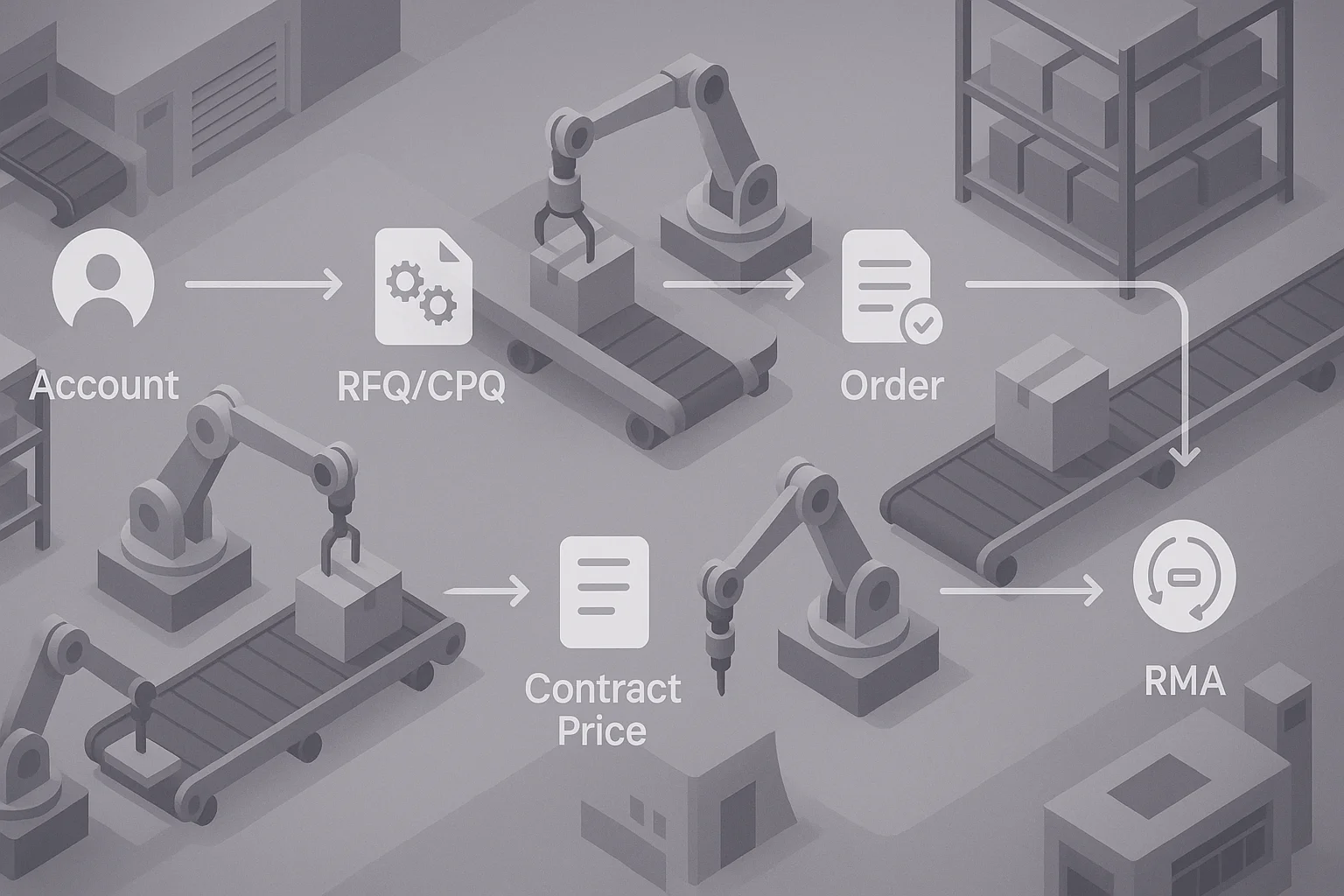Composable B2B on Your Cloud: The Manufacturer’s Guide to Maximum Control
TLDR: Own the experience. Keep vendors replaceable. Expose commerce and CPQ as APIs. Run orchestration on AWS. Enforce data contracts for price, credit, tax, and inventory. Measure RFQ→Order time, accuracy, and uptime. You get control today and flexibility tomorrow.
What “API-first services + your own front end” really means
API-first means your core capabilities live behind REST or GraphQL: catalog, pricing, availability, cart, quote, order, returns, CPQ, identity. Your front end is a thin client that talks only to those APIs. Most teams pick Next.js for the dealer portal. You can swap services without rewriting the UI. That is the point.
When this approach fits
- You want precise control over the dealer journey and approvals.
- Your configuration rules drive routing and lead times.
- You need deep integrations with ERP, PLM, WMS, TMS, and internal services.
A reference architecture that works
Front end is a Next.js portal that serves pages fast and behaves like an app. The commerce core exposes catalogs, price books, quotes, and orders as APIs. You can build that core with Node using Fastify or NestJS, start from an open-core like Medusa or Saleor, or stand up a commercial headless engine behind your own gateway.
CPQ runs as its own service. It validates options against rules tied to real operations. That separation lets you evolve configuration without touching checkout.
On AWS, put API Gateway in front. Use Lambda for micro logic. Use SNS and SQS for async fan-out. Use EventBridge for domain events. Use Step Functions for long workflows like Quote to Approval to Order to Schedule to Ship.
The glue is clear data contracts. Price, credit, tax, inventory, and configuration payloads get versioned and validated at the edges. Bad data dies early.
Security and identity
Enterprise buyers expect single sign on and role based access. Use Cognito or Keycloak for SAML or OIDC. Map roles to account hierarchies: dealer admin, buyer, approver, inside sales, credit, logistics. Centralize policy. Do not scatter permissions across UI components.
Observability and operations
Trace requests end to end with CloudWatch and X-Ray. Correlate logs with IDs that follow a request from the portal to the ERP. Emit events for RFQ created, quote approved, order booked, backorder raised, shipment confirmed.
Tie alerts to service level objectives that matter: latency, error rate, sync freshness, quote calculation time, ERP round trip time.
Data and search
Keep the product truth in PIM. Attributes and assets flow to the commerce core and CPQ. Avoid shadow fields in the portal. For discovery, use a managed engine or OpenSearch. Index by part, compatibility, fitment, lifecycle status, and replacement paths so dealers can find parts fast.
Payments, terms, and tax
Dealers expect terms. Keep underwriting, invoicing, and collections in the same flow. Offer cards where they help. Do not rely on them as a crutch. Centralize tax calculation. If tax is wrong, everything downstream suffers.
CI/CD and infrastructure as code
Use CDK or Terraform so every environment is reproducible. Build pipelines that lint, test, and validate contracts. Run integration tests against a seeded ERP sandbox. Use blue-green or canary deploys for API changes.
A day in the life for a dealer
A dealer signs in with SSO and lands on a personalized dashboard. They configure a product. The portal calls CPQ, which checks rules and returns a valid build with price and lead time. They add it to a quote. Contract pricing and tax calculate through APIs. Credit check runs async. An approver reviews and confirms. The system books the order and reserves inventory in the ERP. Events fan out to WMS and TMS. Everyone sees the same dates and status without email chains.
Choosing components without lock-in
Pick parts you can replace. If a vendor stumbles, you swap it behind your API. Keep schemas and contracts in your repo. Vendors adapt to your contracts, not the other way around.
Risks to avoid
- Do not leak vendor SDKs into the front end.
- Do not hide business rules in UI code. Put rules in services with tests.
- Do not skip contract tests. One ERP change can break quote math.
The outcome
You get control and fewer black boxes. The stack grows with your roadmap. New channels and product lines plug into the same contracts. Costs are transparent because the cloud is yours and the code is yours.
Where Metrotechs fits
We stay vendor neutral and outcome focused. We measure success by quote to order time, dealer self service, order accuracy, fill rate, margin by channel, and uptime.
- Commerce Health Check. Baseline systems and flows. Prioritized plan tied to KPIs.
- Platform and Data Architecture Strategy. Clean target architecture and data contracts. Vendor selection without lock-in.
- Performance Governance. PMO discipline that keeps scope, budget, and quality in bounds while dashboards track the metrics that matter.





